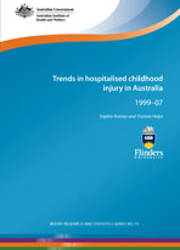Summary
This report provides summary data on trends in hospitalised childhood injury for the period 1 July 1999 to 30 June 2007. Information is provided for three age groups (0-4, 5-9 and 10-14) for each year; information is also presented on the top five causes of hospitalised injury to children in Australia.
Almost half a million children were hospitalised as a result of an injury during the reporting period, boys outnumbering girls by a factor of 2 to 1.
Falls were the main cause of hospitalised injury (n = 193,141), and transport-related injuries were also common (n = 66,864). For all but one cause, cases of hospitalised injury were more numerous in boys compared with girls: for the category of intentional self-harm 3,514 girls were hospitalised compared with 837 boys.
Falls and other unintentional injuries were the most frequent causes of hospitalised injury in each of the three age groups. The most frequent cause of hospitalised falls in children aged up to 9 was falls involving playground equipment. At older ages falls involving roller-skates and skateboards were more common.
For 0-4 year olds poisoning by pharmaceuticals and the effects of exposure to smoke, fire, heat and hot substances accounted for 17% of hospitalised injuries. In 5-9 and 10-14 year olds transport incidents accounted for 14% and 23% of all hospitalised injuries respectively.
The rate of hospitalised injury changed little during the reporting period, there being about 1,500 cases per 100,000 children each year. A small (less than 1%) but statistically significant decline in the rate of hospitalised injury was seen overall during the period. There were no significant changes in the rates of fall injuries, other unintentional injuries, transport injuries and injuries due to the effects of exposure to smoke, fire, heat and hot substances. The only significant decline in childhood hospitalised injury was seen in the rate for poisoning by pharmaceuticals, for which the average decrease was 7.5% a year.



